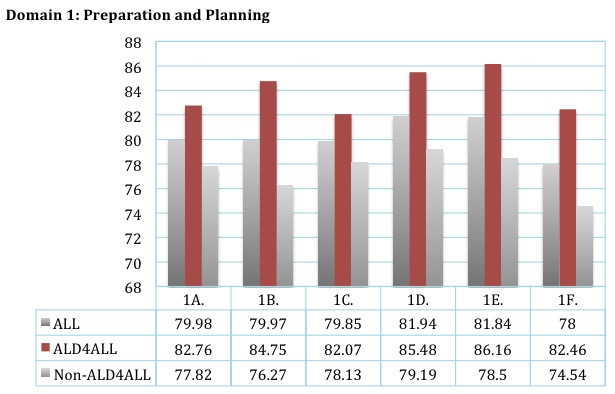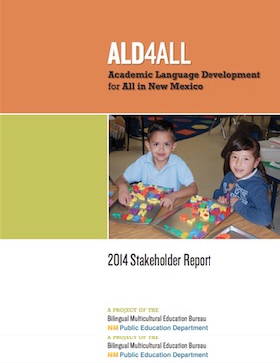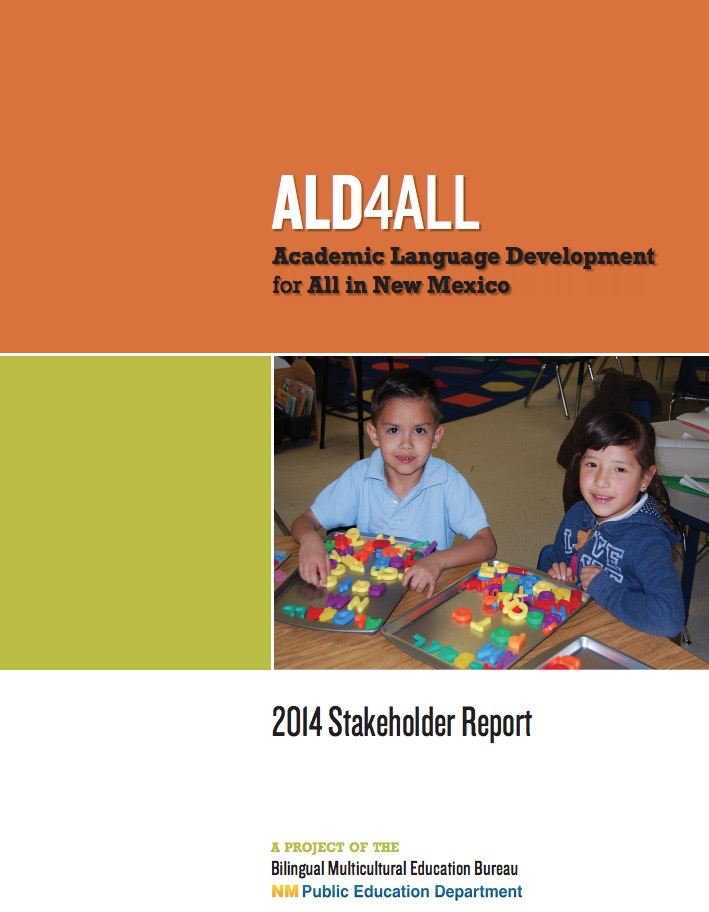Several ALD4ALL schools presented at the 2015 New Mexico Association for Bilingual Education (NMABE) conference in Albuquerque in April 2015. Below is are quick over of some of their presentations.
ALD4ALL Team Presents at AERA 2015
The ALD4ALL team presented at the American Educational Research Association (AERA) on the design, activities, and outcomes of the ALD4ALL project.
2014 Stakeholder Report
Teacher Efficacy and ALD4ALL
Teacher Efficacy, defined in the ALD4ALL project as teachers' personal assessments of their own personal capabilities to perform designated instructional tasks, has been widely studied in many contexts over many years (e.g. Bandura 1986; Multon, Brown & Lent, 1991; Protheroe, 2008).
The Teacher Self-Assessment Scales (TSAS), an online and optionally paper-based instrument designed to measure teacher efficacy aligned to the four domains and 22 items of the state-mandated teacher evaluation framework (NMTEACH) was created.
In September 2014, 114 ALD4ALL teachers and administrators representing the project schools submitted entries for the TSAS using an online form. Results for each project school were computed and interpreted in school-specific reports. A program-wide version was also created that compared results from ALD4ALL schools with results from teachers in non-ALD4ALL schools.
Results were remarkable. Collectively, ALD4ALL schools consistently assess themselves at markedly higher levels on all domains in the measure than all other aggregate schools and teachers present in the TSAS dataset. A sample chart that represents consistently similar results across all domains and items of NMTEACH is presented in the figure below.

Download a briefing on this finding: Teacher-Efficacy-ALD4ALL-201504
Guskey Evaluation Framework Message
Dear ALD4ALL Facilitators,
As you may recall, we agreed to implement the Guskey professional development evaluation framework. I was hoping to administer this measure orally in interviews with key participants at the various school sites. Therefore, I adapted and constructed a modified Guskey instrument that can be used as a pen-and-paper questionnaire. It can also be used as an structured oral interview protocol (preferably recorded) with key participants. I'll leave it up to each team member how to best administer this assessment, or we can discuss options as needed. You can download a PDF of this new instrument at:
ald4all.positivepractices.com/_pdfs/ALD4ALL-CPP-Guskey-Eval.pdf
Thanks for everything, Joseph
ALD4ALL 2014 Stakeholder Report Announcement

The ALD4ALL 2014 Stakeholder Report
is available for viewing or download.Effective Practices in Bilingual Multicultural Education Programs
Overview
The ALD4ALL Project has several objectives and components for improving bilingual-multicultural education in New Mexico. A major component of the project is to conduct an inquiry into the effective practices for improving the education of Culturally and Linguistically Diverse (CLD) students, including English Learners (ELs). Findings from the inquiry would then inform the design and development of new approaches for professional learning for teachers and administrators. The project team structured the inquiry using a framework of systemic indicators put forth by Cadiero-Kaplan (2004).
Cadiero-Kaplan's indicators of effective practices—Value of Learner, Academic Language Orientation, Expectations for Learners, Instructional Goals, Resources, Assessment and Accountability, and Program Approaches are a source of inquiry that provides a structure for systemic inquiry.
The inquiry team conducted site visits and ongoing data collection at 12 schools identified for their promise and achievement in New Mexico. Using expanded definitions of Cadiero-Kaplan's indicators, the team conducted 98 classroom observations and numerous participant interviews and focus groups at 12 participating schools who were chosen because of their promise and achievement in serving CLD students.
The findings—that we term Effective Instructional Practices—include the following:
- Effective Instructional Practices
- Child-Centered Value of Learners;
- Holistic Academic Language and Literacy Orientation;
- Expectations for Active Learners;
- School/Program-Wide Instructional Planning;
- Resources for Learning in a Bilingual Context;
- Performance-Based Assessment and Accountability, and
- Bilingual-Multicultural Education Program Models.
The inquiry findings demonstrated that there are varying levels of implementation of these effective practices and that not all schools demonstrated similar levels on all indicators. For instance, some schools easily epitomized one of the indicators, while other schools were more balanced across some or all the indicators.
Child-Centered Value of Learners
Draw on students’ experiential background and skills to meet learning goals.
Students learn best when their home language, learning preferences, and community practices are leveraged to further advance their academic, socio-emotional, and spiritual development. Teachers can improve English learners (ELs) learning outcomes by using culturally and linguistically responsive teaching practices (Tharp et al., 2000; Villegas & Lucas, 2002) that draw upon students’ cultural and linguistic resources by accessing their prior knowledge and relevant experiences and skills. These practices have been found to develop literacy comprehension and decoding/encoding skills among ELs (August & Shanahan, 2006; Escamilla et al., 2013).
Indicators of Student-Centered Value of Learners
The educator:
- acknowledges the diversity of the students in their classroom by including the multiple cultural identities that children have acquired from their home/community practices;
- offers opportunities for students to use their different learning preferences by engaging them through various forms of learning such as dancing, singing, art, and music participation;
- values students’ home language as a resource for learning across different disciplines;
- learns about students’ and families’ funds of knowledge (Gonzalez, Moll & Amanti, 2005), cultural and linguistic resources, and experiential practices by engaging students, parents, and community members in the development and application of place-based learning;
- practices multiple ways of valuing success in the classroom by including academic, socio-emotional, spiritual, and social justice approaches to learning and assessment;
- assures children’s participation in their learning by embracing a stance that ALL children can learn, and
- makes the classroom culture inclusive of ALL children.
Holistic Academic Language and Literacy Orientation
Teach multidimensional uses of language explicitly, across all content areas ensuring real-world applicability of concepts and skills learned.
Academic language goals are met when the teacher extends learning beyond vocabulary skills to include discourse competence that requires linguistic knowledge―knowing how to act, talk, interpret, and think according to the particular cultural or social group (Gutiérrez, 1995). Students’ application of language in real-world situations increases their use of language in functional and communicative ways that vary according to context (Schleppegrell, 2004).
Using language in multidimensional ways, including speaking and writing, encourages students to use their everyday forms of language as a means of understanding the language of texts (i.e. the use of popular culture such as media to better comprehend texts)(Bailey & Heritage, 2008).
Disciplinary literacy involves written and spoken expression of complex ideas and concepts that are embedded in the context of a subject essential for learning the core curricula making use of the multiple literacies that students bring to the teaching-learning process (Gee, 2007 Gibbons, 2009; 2002).
Indicators of Holistic Academic Language and literacy Orientation
The educator:
- knows the language of the classroom and texts, for example, use of content-based vocabulary, language forms and conventions, and language complexity;
- identifies and understands the functions of academic language and disciplinary literacy and how to use it to expand students’ social and linguistic capital;
- understands that discourse (ways of communicating oral or spoken language) is a social practice and varies across contexts and groups;
- recognizes that the students’ home and community experiences influence their literacy and language development and uses in instruction, and
- encourages students to develop academic language in their first and second language strengthening their bilingualism and biliteracy.
Expectations for Active Learners
Communicate clear learning goals and objectives while expecting all students to demonstrate growth.
Effective educators set goals and objectives that ensure clear expectations for learning by actively involving students in applying solid fundamental skills, critical thinking, logical reasoning, and numeracy and literacy in creative problem-solving ways.
Teaching and learning is not only an individual endeavor, but is also socially mediated and context-dependent (Vygotsky, 1978). Effective educators recognize this and also that individuals possess valuable funds of knowledge (Gonzalez, Moll & Amanti, 2005). Therefore, ALL teachers should view their students as capable learners who can negotiate meaning with others and become active, self-regulated learners and decision-makers. Teachers and students need to have a shared understanding about the students’ boundless potential to meet expected outcomes, demonstrate growth, and use critical thinking to succeed in school.
Indicators of Expectations for Active Learners
The educator:
- studies the content of relevant national, tribal, state, and/or local standards and develops an achievement plan for student performance;
- identifies clear expectations for learning by stating the overall learning goal(s), defining objectives, and clearly articulating the steps to accomplish the goal(s);
- organizes learning where students and teacher are collaboratively negotiating meaning during instruction (e.g., instructional conversation);
- understands that ALL children are capable learners by supporting their positive self-efficacy;
- designs opportunities to explicitly teach students the social capital necessary for an equitable education;
- creates opportunities for students to be active participants in decision-making about their learning;
- builds a classroom community that collaboratively sets the expected behaviors and rules, and
- helps students examine curriculum from multiple perspectives.
